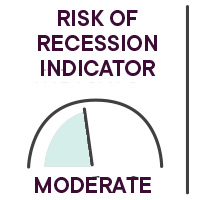Yann Furic
B.B.A., M. Sc., CFA®
Senior Portfolio Manager, Asset Allocation and Alternative Strategies
A mixed month
The month of January, and more particularly the last days of the month, were marked by a market event now known as the GameStop phenomenon. It made the headlines and sparked strong reactions from investors and regulators.
As far as businesses are concerned, results for the fourth quarter of 2020 have started to be released and overall they are beating expectations in terms of both sales and profits. In recent weeks, the announcement of this strong performance has led to an increase in projected earnings for 2021.
In both Canada and the United States, job creation numbers were disappointing, as were the revised numbers for last month.
Focus on the past month

Overview of global equity markets*
- The flagship index of the Canadian stock market, the S&P/TSX, fell 0.6% in January.
- In the United States, the S&P 500 lost 0.75%, while the Nasdaq gained 1.7%.
- International stock markets were in negative territory during the month, with the EAFE index declining 0.78%.
- Emerging market equities rose 3.27% in January, while Chinese stocks were up 7.66%.
* All the percentages in this section are in Canadian dollars. Bloomberg unless otherwise indicated.
Key events

The GameStop phenomenon
The massive purchases of this stock and a few others by small investors resulted in a reduction in the risk level of many hedge funds. This situation escalated and led to a sharp drop in global equity indices on the last day of the month.
Pandemic: vaccination slowdown
Vaccination campaigns are continuing, but production problems are slowing the rollout. The availability of vaccines and the speed at which people can be vaccinated will dictate the return to normal, which could vary significantly from one country to the next.
American stimulus package
The new U.S. administration wants to introduce a $1.9 trillion economic stimulus package, which the Republican Party opposes because it considers it too generous.
Employment situation
Job creation was negative in Canada and positive in the United States:
- 212,800 jobs were lost in Canada, compared to the forecast of 40,000. The unemployment rate rose from 8.6% to 9.4%.
- In the United States, 49,000 jobs were created versus expectations of 105,000. The jobless rate fell from 6.7% to 6.3% due to, among other things, a reduction in the labour force.
The job losses obviously had a negative effect on the economy, but we mustn’t forget that the affected sectors continue to be those suffering the impacts of the partial lockdown measures, made necessary by the second wave of COVID-19.
Results – Canadian bonds
Government of Canada bonds across maturities posted a negative return of 1.1% for the month, weighed down by rising interest rates. (Source: Canaccord Genuity)

Our strategic monitoring
Main risks
Here are some risks we are closely monitoring in the current environment.
- Vaccine production problems or a variant that does not respond to vaccination would limit the cyclical recovery.
- A sharp rise in interest rates would lower the price/earnings ratio, which would lead to a drop in the indices.
- Governments could significantly raise corporate and personal tax rates to replenish their coffers. However, this scenario is unlikely in 2021.
- Inflation could rise sharply without corresponding economic growth, which would trigger an episode of stagflation.
Fundamental indicators
Some economic indicators that we continued to monitor in January.
Consumer confidence ![]()
The consumer confidence index remained below 100 in January, just as it was in December. Vaccination campaigns should restore consumer confidence, especially in terms of job creation.
U.S. personal savings ![]()
In 2020, Americans’ savings totaled approximately $1.5 trillion. This money, some of which came from government aid cheques, should be reinvested in the U.S. economy in the second half of 2021, as things gradually return to normal.
Global Purchasing Managers’ Index ![]()
The index is at 53.5, down slightly from last month. A reading above 50 signals an increase in purchasing managers’ intentions. Overall, most countries are seeing a rise in purchase intentions in the manufacturing sector which, combined with low inventories, augurs well for the economy.
U.S. retail inventory-to-sales ratio ![]()
This ratio improved again, but remains close to its 15-year low. The slowing or shutdown of production of many goods during the health crisis resulted in inventory shortages, as sales continued to rise. The resumption of production to rebuild inventories is a positive sign.
Benchmark rates in Canada, Europe and the United States ![]()
Rates remain at low levels, which is favourable for an economic recovery. Central banks are still standing by, ready to step in. This situation will likely continue until their economies return to a satisfactory rate of growth, even if it means letting inflation exceed targets before tightening monetary policies.
François Landry
CFA®
Vice-President and Chief Investment Officer
Vice-Chairman of the Board of Directors of Professionals' Financial - Private Management
Our strategies
(6-to-12 month horizon)
The availability of vaccines should dictate the reopening of global economies, which will happen at different rates. This reopening should help cyclical stocks that benefit from the recovery as well as small caps and, to some extent, emerging market equities. In Canada, the S&P/TSX and small cap indices have a higher weighting of cyclical stocks, i.e. financials, basic materials, industrial products and energy. As for technology stocks, they will continue to benefit from the structural changes accelerated by the pandemic.
The strategic target of the FDP Tactical Asset Allocation Private Portfolio is 65% equities and 35% bonds. Because of market movements, the equity weighting rose to 68%, while the bond weighting fell to 32%.
The geographic allocation of equities in our portfolios remained the same. The equity weighting is neutral with no regional deviation, the expected return being roughly the same in all cases. However, sector or factor positioning may have varied from one region to another.
- Our Canadian equities have a favourable bias towards banks.
- As for U.S. equities, we added exposure to small caps through the Russell 2000 Index. We maintained our exposure to technology stocks and industrial products, which should benefit from announced infrastructure spending and the global economic recovery.
- In the case of the regions represented in the EAFE index (Europe, Australasia, Far East), the slowdown in the vaccination of the population and the partial lockdown measures in euro zone economies are delaying the economic recovery.
François Landry, CFA
Vice-President and Chief Investment Officer
Yann Furic, B.B.A., M. Sc., CFA
Senior Portfolio Manager, Asset Allocation and Alternative Strategies
Sources: Bloomberg
The opinions expressed here and on the next page do not necessarily represent the views of Professionals’ Financial. The information contained herein has been obtained from sources deemed reliable, but we do not guarantee the accuracy of this information, and it may be incomplete. The opinions expressed are based upon our analysis and interpretation of this information and are not to be construed as a recommendation. Please consult your Wealth Management Advisor.









